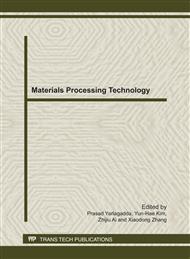[1]
P.C. Paris, M.P. Gomez. and W.E. Anderson: A rational analytic theory of fatigue.The Trend in Engineering Vol. 13(1961), p.9~14.
Google Scholar
[2]
H.H. John, P.C. Paris: Sub-critical flaw growth. EngngFracture Mech Vol.1(1968), pp.3-45.
Google Scholar
[3]
J.W. Hutchinson and P.C. Paris,Stability Analysis of J-Controlled crack Growth.Elastic-Plastic Fracture,ASTM STP Vol.668(1979), pp.37-64.
Google Scholar
[4]
K.J. Miller: The Behaviour of Short Fatigue Cracks and Their Initiation, Part Ⅱ–A General Summary.Fatigue Fract. Engng. Mater. Struct. Vol. 110, (1987), pp.93-113.
DOI: 10.1111/j.1460-2695.1987.tb01153.x
Google Scholar
[5]
P.Lazzarin, R.Tovo and G.meneghettit: Fatigue Crack Initiation and Propagation Phases near Notches in Metals with Low Notch Sensitivity. Int. J. Fatigue, Vol.119(1997), pp.467-457.
DOI: 10.1016/s0142-1123(97)00091-1
Google Scholar
[6]
K.Sadananda, A.K. Vasudevant: Short crack growth and internal stresses. Int.J.Fatigue Vol. 119 (1997), pp.99-108.
Google Scholar
[7]
M.D. Chapetti , T.Kitano and T.Tagawa et al: Two small-crack extension force concept applied to fatigue limit of blunt notched components. Int.J. Fatigue Vol. 121(1999), pp.78-82.
DOI: 10.1016/s0142-1123(98)00057-7
Google Scholar
[8]
Y.Madi, P.Matheron, N.Recho, et al. : Low cycle fatigue of welded joints: new experimental approach. Nuclear Engineering Design Vol. 228 (2004), p.161–177.
DOI: 10.1016/j.nucengdes.2003.06.016
Google Scholar
[9]
Y.Madi, N.Recho, P.Matheron: Low-cycle fatigue of welded joints: coupled initiation propagation model. Nuclear Engineering Design Vol. 228(2004), p.179–194.
DOI: 10.1016/j.nucengdes.2003.06.017
Google Scholar
[10]
P.J. Hurley, M.T. Whittaker, S.J. Williams et al: Prediction of fatigue initiation lives in notched Ti 6246 specimens.International Journal of Fatigue Vol. 30 (2008), p.623–634.
DOI: 10.1016/j.ijfatigue.2007.05.013
Google Scholar
[11]
K.Schoeler, H.J. Christ: Influence of prestraining on cyclic deformation behavior and microstructure of a single-phase Ni-base super alloy. International Journal of FatigueVol. 23, (2001), p.767–775.
DOI: 10.1016/s0142-1123(01)00039-1
Google Scholar


